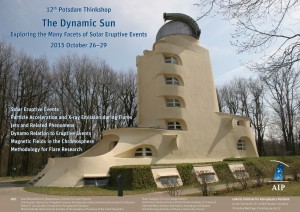Multi-instrument Observations of a Delta-spot Hosting a C4.1 Flare
Salvo L. Guglielmino (Università degli Studi di Catania)
Abstract. We present the analysis of multi-instrument space- and ground-based observations relevant to a C4.1 flare occurred in the active region NOAA 11267 on 2011 August 6. At the peak, the flare was observed by the X-Ray Telescope on board the Hinode satellite. These unique observations reveal that the bulk of the X-ray emission takes place in the delta-spot region, where the plasma heats up to 20 000 000 K. During the gradual phase, we observe in images taken in the ultraviolet with the SDO satellite the development of a Y-shaped structure in the corona and in the high chromosphere. An extruding structure also forms, being directed from the emitting region above the delta spot toward the following sunspot of the active region. High-resolution (0.15 arcsec) ground-based observations performed at the Swedish 1-m Solar Telescope in the core of the Ca II H chromospheric line indicate a decresing trend, with some transient enhancements, of the intensity in the flare ribbons during the late gradual phase. All these findings suggest to interpret this event as a manifestation of magnetic reconnection, likely induced by an asymmetric magnetic configuration in a highly sheared region. This research work has received funding from the European Commission’s Seventh Framework Programme under the grant agreements no. 606862 (F-Chroma project) and no. 312495 (SOLARNET project). This research is also supported by the ITA MIUR-PRIN grant on ‘The active sun and its effects on space and Earth climate’ and by Space Weather Italian COmmunity (SWICO) Research Program.
Poster
